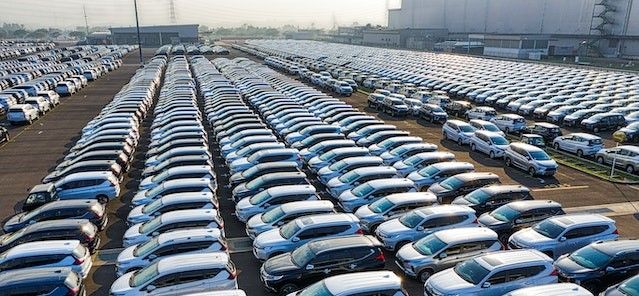The previous two years have shown that the just-in-time inventory system is unable to take the strain of a global health pandemic. A strategy intended to boost efficiency and minimize costs has actually proved to be more expensive when the unexpected happens.
In order to reduce the chance of any future supply chain collapse, business analysts and company managers are now reconsidering the importance of minimal inventories in favour of sturdy supplier relationships and supply chain resilience.

Learning from this situation has made manufacturers change how they approach their raw material management. This was made clear through research by Deloitte and the Manufacturers Alliance who have surveyed more than 200 executives from the manufacturing sector to get an insight into how companies are re-thinking their feedstock needs, with the results now published in the report Meeting the Challenge of Supply Chain Disruption.
The study takes a close look at how traditional manufacturers are adapting their supply chains to carefully balance low inventory levels with shock resilience all while keeping buying costs to a minimum.
The report makes for uncomfortable reading, as manufacturing expert Rob Spiegel explains, “The results indicated that 80% of respondents have experienced a heavy supply chain disruption in the previous 12-18 months. The disruptions include shipping delays, part shortages, and transportation delays due to truck driver shortages and congested ports. Other manufacturers are facing operational concerns when trying to fulfil contracts including rising costs (46%), product issues from suppliers struggling to meet demand (43%), and logistical challenges when implementing new supply chains or contingency planning approaches (43%).”
To avoid these issues in the future, procurement officers are changing their buying and inventory strategies. In a nutshell, the report highlighted four main strategies being adopted.
1. Supply Chain Diversification.
The study found that 81% of manufacturing executives are working to engage multiple suppliers.
While geographic changes were important, the survey showed that having a general spread of suppliers was more important than location, with cost still remaining a high concern for 41% of respondents.
2. Stronger Supplier Relationships.
The report found that the greatest concerns for manufacturers were over product issues caused by suppliers failing to meet demand. To combat this 83% of respondents were investing in rebuilding relationships with existing suppliers.
“Strengthening needs to take place in all aspects of the supplier relationships. Communication needs to improve down the line,” says Paul Wellener, vice chair of US Industrial Products & Construction at Deloitte. “You need to make things easier for the supplier by improving the relationship with better communication. This has been driven by two years of Zoom calls.”

3. Increasing Minimum Stock Levels.
65% of those questioned reported that they were no longer following a just-in-time supply system, but have instead adopted a just-in-case approach to feedstock inventory.
The situation has perhaps been most stark for the automobile industry, which experienced extreme disruption to production through a lack of semiconductors. As a recent report from Reuters notes, “Skoda Auto saw its global deliveries fall by 16.7% in 2022 due to parts shortages and supply chain problems.”
The situation has still not been rectified almost two years after the pandemic began, with a Skoda stopping all car production since October 2022. The automobile journal SasaTimes reporting that, “This decision was made due to a shortage of microprocessors, which has been hampering the production of cars for several months. The company’s three Czech factories will be affected by this decision, and new cars will not be delivered until next year [2023].”
It seems that not having what you need can be very expensive indeed.

4. Digitalisation.
Once a key buzzword for all sectors of the economy, supply chain disruptions have highlighted the need for manufacturers to further embrace computing to not only streamline supplies, but to avoid delays.
Specifically, the report found that 78% of manufacturing executives agree that digital solutions and monitoring tools would help resolve glitches early with 76% taking active measures and investment to ensure it would happen.
At the same time, 88% of respondents were worried about the ramifications of having such a key part of the business digitalised. These fears include privacy, IP theft, legal issues, and cybersecurity.
“As we become more connected, there is a greater focus on cybersecurity and becoming more resilient,” says Wellener. “You have to work with existing suppliers to fortify their security, and when you bring in new suppliers, you have to make sure they are up to the security requirements. You have to look at the entire supply chain with cyber concerns, especially when you have multi-tier suppliers.”

The collapse of the global supply chain has caused consumers a great deal of inconvenience, but worse still for suppliers and manufacturers, it has wasted a great deal of profit.
In fact, 50% of respondents stated that productivity and profits had been significantly affected. While 80% of surveyed executives claimed that at least one disruption had caused a heavy or very heavy impact on their overall supply chain. Almost all (90%) stated that disruptions were even becoming more frequent.
With health experts warning that the next pandemic will happen, and possibly sooner, rather than later, it is time for all manufacturers to ask, “How should we adapt our current supply chain?” and “Are we ready for the next pandemic?”
Photo credit: Tomas Adomaitis on Freerangestock, WinnieVincenze, Racool, Jack Moreh, & Tom Fisk on Pexels